Family : Anatidae

Text © Dr. Gianfranco Colombo

English translation by Mario Beltramini
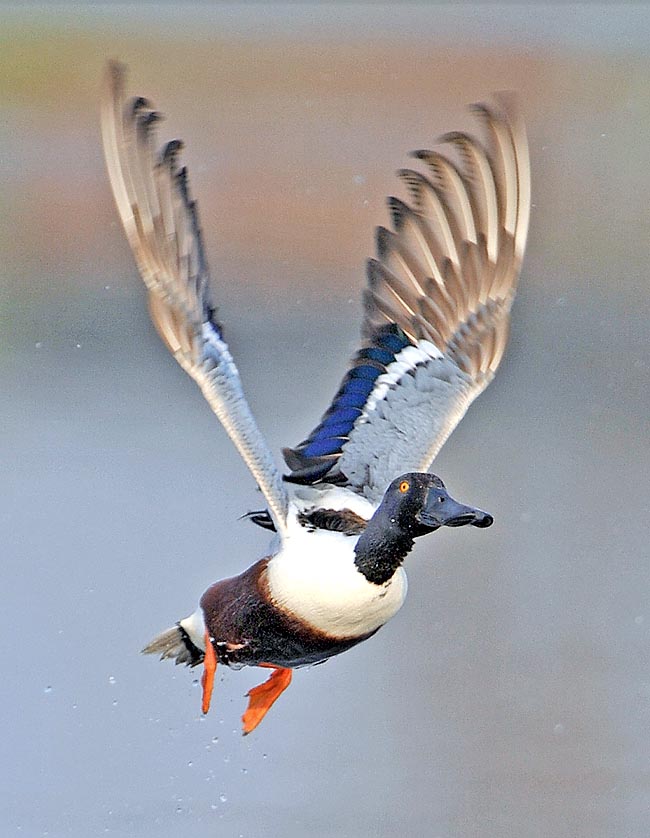
Diffused in Europe, the Northern shoveler (Anas clypeata) is an excellent flyer © Gianfranco Colombo
The Northern shoveler (Anas clypeata Linnaeus, 1758) belongs to the order of the Anseriformes and to the family of the Anatidae and is, with the splendid colours of its livery, one of the most beautiful ducks of the Palearctic.
Already in this numerous group we meet plumages standing among the most striking of the avian world, with varieties of colours at times unthinkable and with combinations and contrasts creating real flying palettes.
It is only the drake to display this characteristic, essentially in the prenuptial period and during the nidification and is the main means the nature has given to these birds for the conquest of the female, through a continuous challenge among competitors passing rightly through the exhibition of these wonderful liveries that will lead the females to chose their partner for the reproduction.
The Northern shoveler, if compared to its similars and to be able to stand among the most beautiful ducks, displays however two major handicaps that if observed with the eye of an esthete, can de-class this wonderful duck to positions perhaps undeservedly back.
First of all, the very reduced length of the legs, certainly anomalous if compared with its similars, that oblige it to adopt, when on the ground, a broken and shaky walk, even undulating in an insecure way and make us doubt about the stability of its balance.
It is already used the term walking like a goose, to indicate the staggering gait of these birds but in the case of the Northern shoveler it is even ridiculous. To see it moving ahead gives even the impression of a bird wounded in a leg or, even, that it is unable to do so.
Then there is that big contraption of which the nature has endowed it and from which gets the name, scientific a well as vulgar, and that it is so out of measure to deform the facial morphology obliging it to keep the head usually turned downwards as if it wanted to hide it or maybe for the weight but even more for getting a better frontal view partially occulted by this huge encumbrance.
The bill of the Northern shoveler is something of unusual and so much big, wide, long and deformed to lead to imagine that somebody has glued it as per a joke a fake trinket, not commensurate to the size of this duck, so elegant when flying or floating on the water. Already Linnaeus had described its enormity declaring “Anas rostri extremo dilatato rotundato ungue incurvo”. The Anglo-Saxons, masters in naming familiarly and in a folkloric way every bird, have christened it ”Shoveler” = digger and this definition would be itself sufficient to describe this bird.
Nevertheless in every corner of the world where it is known, in the local jargons as well as in the common names officially given, it always carries this abnormal characteristic it has. Also in Italian besides the name of Mestolone, logically derived from mestola (ladle), we find local names very characteristic and self explanatory, such as palettone, beccone, cucciaron, paloton, paleta, mestola but also the Anglo-Saxons, the Americans in particular, don’t split hairs in giving strange nicknames, based also on the sympathy this huge bill recalls: Bootlip, Spoonbill, Grinner, Smiling Mallard and Hollywood Mallard.
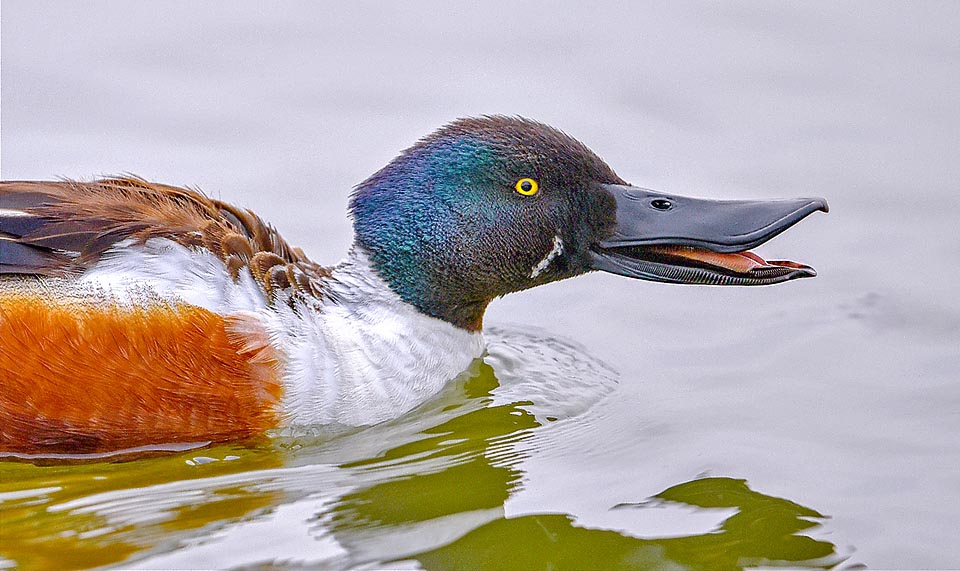
Clumsy on the ground movements, its bill is decidedly unusual and so much big, wide, long and deformed to make you think of a joke © Gianfranco Colombo
About these two last nicknames it is still a mystery about who has coined them and what is their true meaning.
Someone asserts that the Northern shoveler is a Mallard with the smile printed on the face, others that it is a duck that always shows off as do the Hollywood stars, others, perhaps exaggerating on the careless use of the facial lifting, that its bill is the work of manumission of the Botox, rightly imitating that the actresses do to improve or less their features. Anyway, the Northern shoveler would certainly not feel offended by these human fantasies that brighten its appearance, by sure… not normal.
Also the etymology of the scientific binomen, of Latin derivation, remembers this characteristic: in fact the specific appellation is clypeata from “clypeatus” = bearing a shield, whilst the genus Anas simply resumes the Latin translation of duck.
In Europe it is called Northern shoveler in English, Löffelente in German, Cuchara Común in Spanish, Canard souchet in French, Pato trombeteiro in Portuguese and Mestolone in Italian.
The Northern shoveler is counted among the so-called surface ducks, that is in that group including birds that do not totally dive into the water looking for food but that remain floating in surface, immersing up to the possible limit head and neck for reaching the bottom. Consequently it is always visible while laying in water, clearly evidencing in the drake its livery, rendering it easy to distinguish even if associated with other species, unlike the female that, as we shall see, has a strongly camouflaged livery.
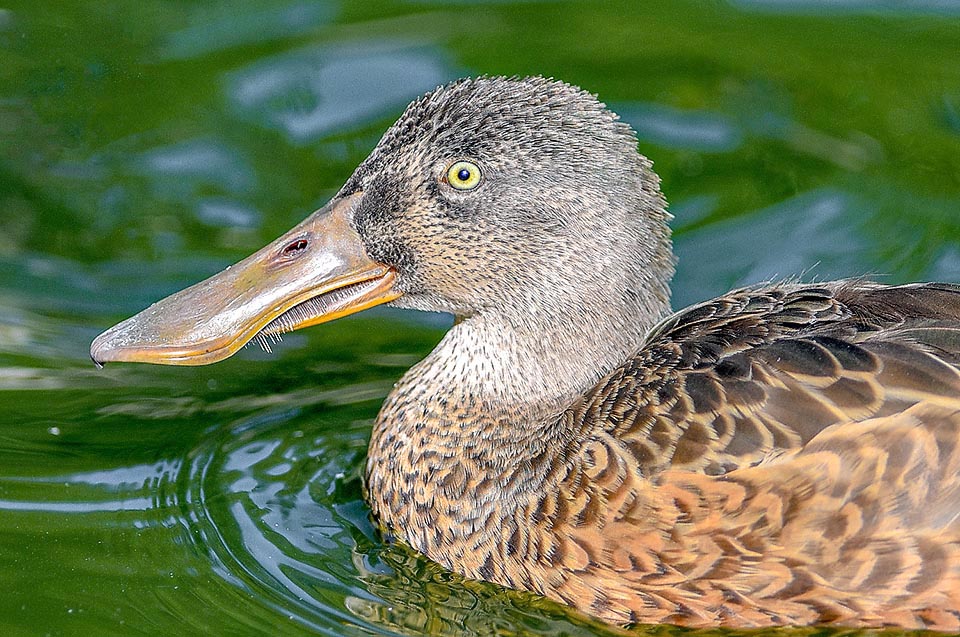
The female has a modest overall colour, as usual. The bill is no exception and we note the rigid barbels, quite similar to the whalebones of a cetacean, through which is filtered the water while looking for the food. The diet is based on lake herbs, roots and seeds but mainly of plankton, aquatic micro-fauna, small insects and mollusks © Gianfranco Colombo
Zoogeography
The Northern shoveler is mainly a long-range migrant but for the European populations can be a short-range and at times even not migratory, occupying areas that have winter conditions sufficiently mitigate.
It is an excellent flyer therefore has no difficulty, if necessary, to move quickly even during the bad season in order to reach more comfortable places, avoiding sudden worsening of the local meteo conditions.
In Europe it occupies all the central-northern part of the continent, reaching even Iceland but avoiding most of the Scandinavian peninsula above the 60th parallel, even if diffusing well to the north in all Russia and Siberia.
It does not nest in the Mediterranean area unless casually and hence is absent in the Iberian Peninsula, in Italy, Greece and near East and also in all Saharan North Africa, places which are, conversely, partially frequented during the wintering period. On these areas converge also part of the populations of East Europe up to the Urals that instead regularly abandon their territory of nesting on the migration route that will take them in the eastern sub-Saharan Africa, in particular on the lakes of the Rift Valley.
In Asia the Northern shoveler is present in all the continental belt placed north of the great central-Asian steppes, up to reach, to east, the coasts of the Pacific Ocean and to the north part of tundra. These populations winter in the extreme southern part of the Asian continent. In the Nearctic is present in Alaska, in Canada and western USA and the wintering occurs in the Central American and Caribbean area.
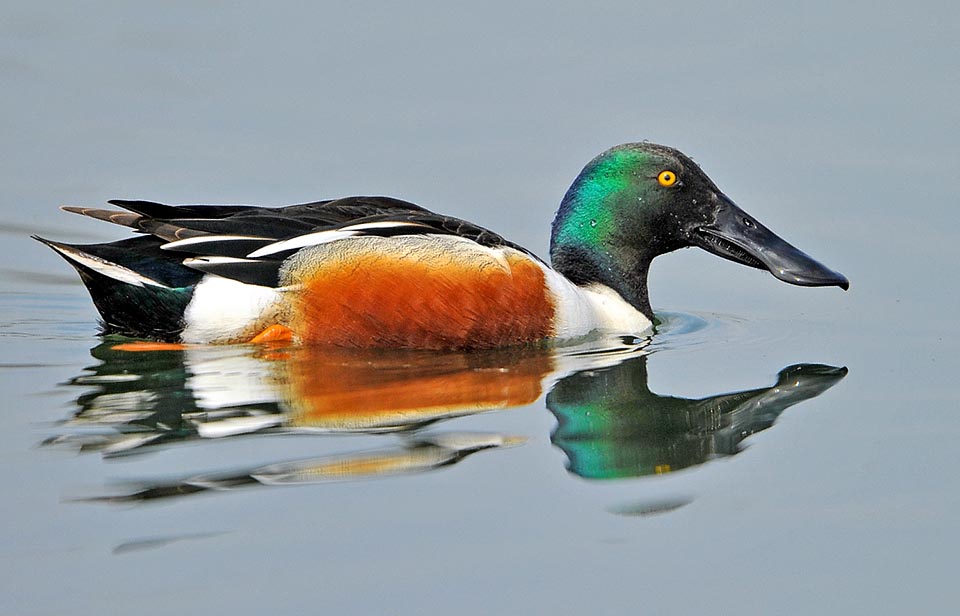
During the reproduction time the drake is at its most, with the head with reflexes changing from green to blue, and candid chest with hazelnut sides and abdomen © Gianfranco Colombo
Contrary to the usual social behaviour of the surface ducks, the Northern shoveler does not form great flocks during the migration but only in the moments of gathering that precede the voyage towards the winter quarters.
Like all ducks, the Northern shoveler needs bodies of still water that do not freeze during the bad season, whereby this particular determines practically the choice of the wintering place.
Ecology-Habitat
The Northern shoveler spends practically its life in water, stopping on the earth only for nesting and for stretching the very short legs even if for this often prefers to remain in low water keeping the feet resting on the bottom.
It is therefore difficult to imagin of seeing it out of this habitat.
In the nesting period, the northern shoveler lives in flooded prairies, open swamps with riparian vegetation, shallow and still waters with vast bodies of water and surrounded by grassy lands or covered by low vegetation where to place its own nest.
During the winter it occupies indifferently similar sites, but also flooded prairies, banks of rivers, small lakes and swamps and every environment having free water. In sub-Saharan Africa it often gathers in the weeks before the migration, in the lakes with shallow waters in discrete flocks.
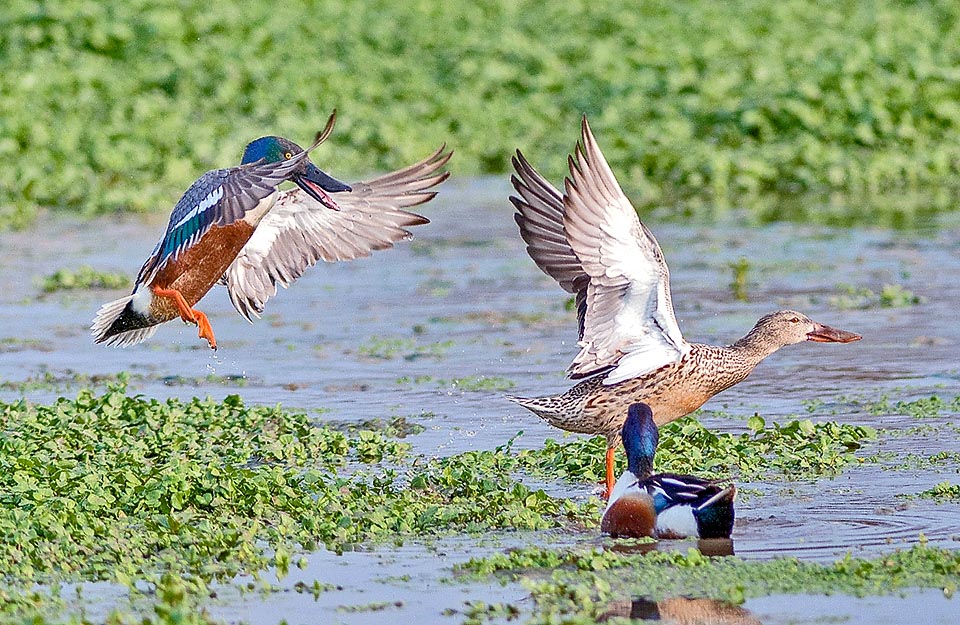
Here the drake is definitely on the attack… but the “chicken dance” does not work and the female takes off © Gianfranco Colombo
Morpho-physiology
The male of this duck is unmistakeable due to the very lively colours of its nuptial livery that remains for the whole period of the courting and during the nidification whilst in the eclipse time its plumage gets paler and more similar to the modest one of the female. The head is bright dark green, changing after the light refraction, the chest is very white whilst sides and abdomen are of hazelnut colour. The eyes are yellow and stand out greatly on the dark head so much to be visible even from far away, as well as the legs that have a nice lively orange colour.
When flying it displays wings with primary coverts of a pale bluish nuance, the speculum feathers are dark emerald green and there is a white band on the secondary coverts.
Conversely, the female is, as is usual in all ducks, diffusely of an amber brownish yellow colour, spotted all over the body with lighter patches of cream colour. Also the wings of the females display the coverts of a greyish glow and also the speculum is fairly pronounced when in flight even if not so strong as in the drake.
It is however easy to note for both sexes the immense and disproportionate bill of which we have already been talking. The bill of the Northern shoveler has the shape of a spatula widening towards the apex and whose lips fold laterally, up to almost double its length at the base and is equipped in the tip of a protuberance shaped like a talon applied with a stud.
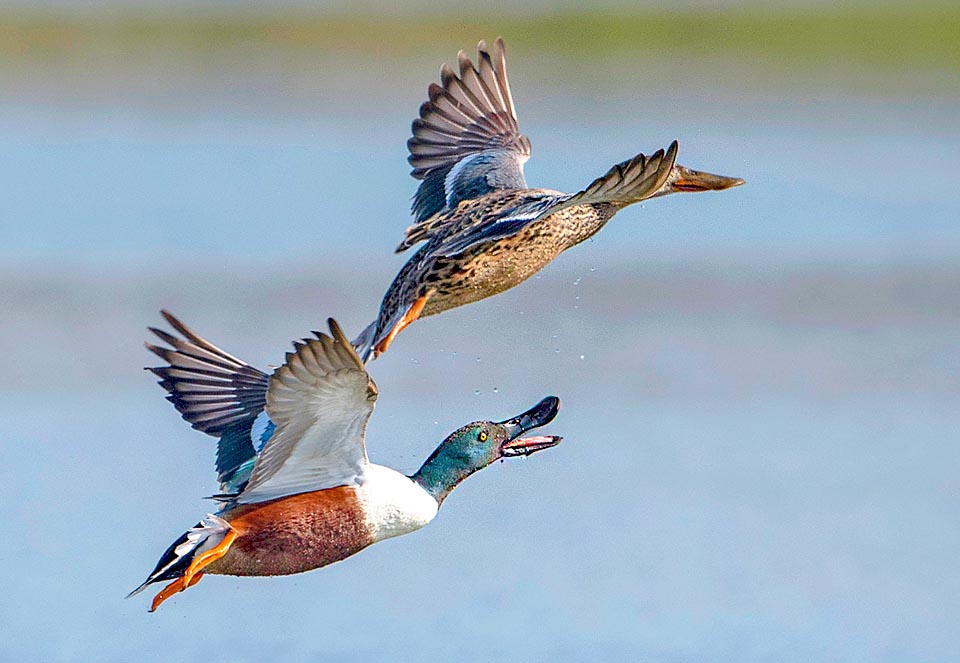
”But what are you doing? Think again. I am the best dad of the zone and I will help you in surveying the chicks” © Gianfranco Colombo
The mandibles are equipped on the borders of rigid barbels, quite similar to the whalebones, through which is filtered the water while looking for food.
The Northern shoveler has indicatively the same size of the Mallard (Anas platyrhynchos), maybe also for the aposematic colours that accentuate visually its measures, even if the weight and the wingspan are however considerably lower. It reaches the length of 50 cm, with a wingspan of about 80 cm and a weight of 800/1.000 g.
No subspecies have been classified.
Reproductive Biology
As it happens for all migratory ducks, the couples form in the sites of wintering and the migration is done together inside small groups, with which probably they will reach the same sites of nidification. Also during the migration the typical behaviour of a couple is kept, with the mutual defence between partners against importunate contacts with other conspecifics and also with the temporary defence of the area occupied for the few days during the stop.
The Northern shoveler is a rather solitary and shy duck and this characteristic is evidenced since the first migratory movements, and then becomes even more marked when arrived in the place chosen for the nidification. It is also quite silent and the sound contacts between partners reduce to a modest quak quak of the female and a light courting toc toc of the drake.
The nest is a platform placed in a small depression in the ground, covered by dry grasses, sedges and leaves, softened and lined by the down released by the female while hatching, a strictly female task in the ducks world.
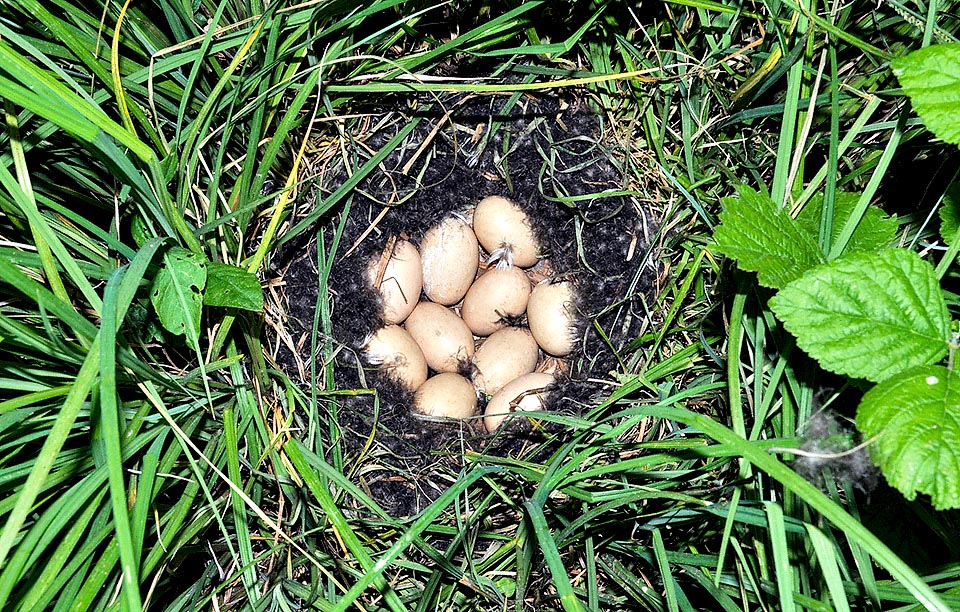
Here is the nest: a platform placed in a small depression in the ground, covered with dry herbs, sedges, leaves and the down released by the female while hatching, task this exclusively female in the world of the ducks. It contains a ten of white olive eggs, then becoming cream or greenish, that will hatch in about 3 weeks © Museo civico di Lentate sul Seveso
About ten white olive eggs are laid that become during the hatching cream and even greenish and that will hatch after about three weeks of incubation.
The chicks, that will be born at the same time within a few hours, will leave immediately the nest to reach the nearest body of water, governed and protected by both partners. They will be immediately capable to nourish autonomously and will reach the full independence during the next 6-7 weeks. It can live a ten of years.
The diet of the Northern shoveler is based on lake herbs, roots and seeds but mainly also of aquatic micro-fauna, of plankton, of small insects and molluscs that it filters through the bristles located on the sides of the bill after having sucked and expelled, like a hydraulic pump, the mud and the water of the bottom. It is a tireless sieve shaker of bottoms and most of its day is spent in this activity.
A somewhat strange characteristic of this duck is the particular noise emitted during the take off. A very noisy flapping of wings, messy and initially little effective so much to appear injured or hampered by some ailment that does not allow it to develop its avian potentialities at the best. However few seconds are sufficient and is immediately in condition to show how much efficient and powerful is its flight.
The Northern shoveler is a duck that has been always amply hunted in the northern hemisphere during its seasonal migrations but the population has not suffered from drastic decreases so much that the species is not considered as endangered.
Synonyms
Spatula clypeata Linnaeus, 1758.
→ To appreciate the biodiversity within ANSERIFORMES please click here.
